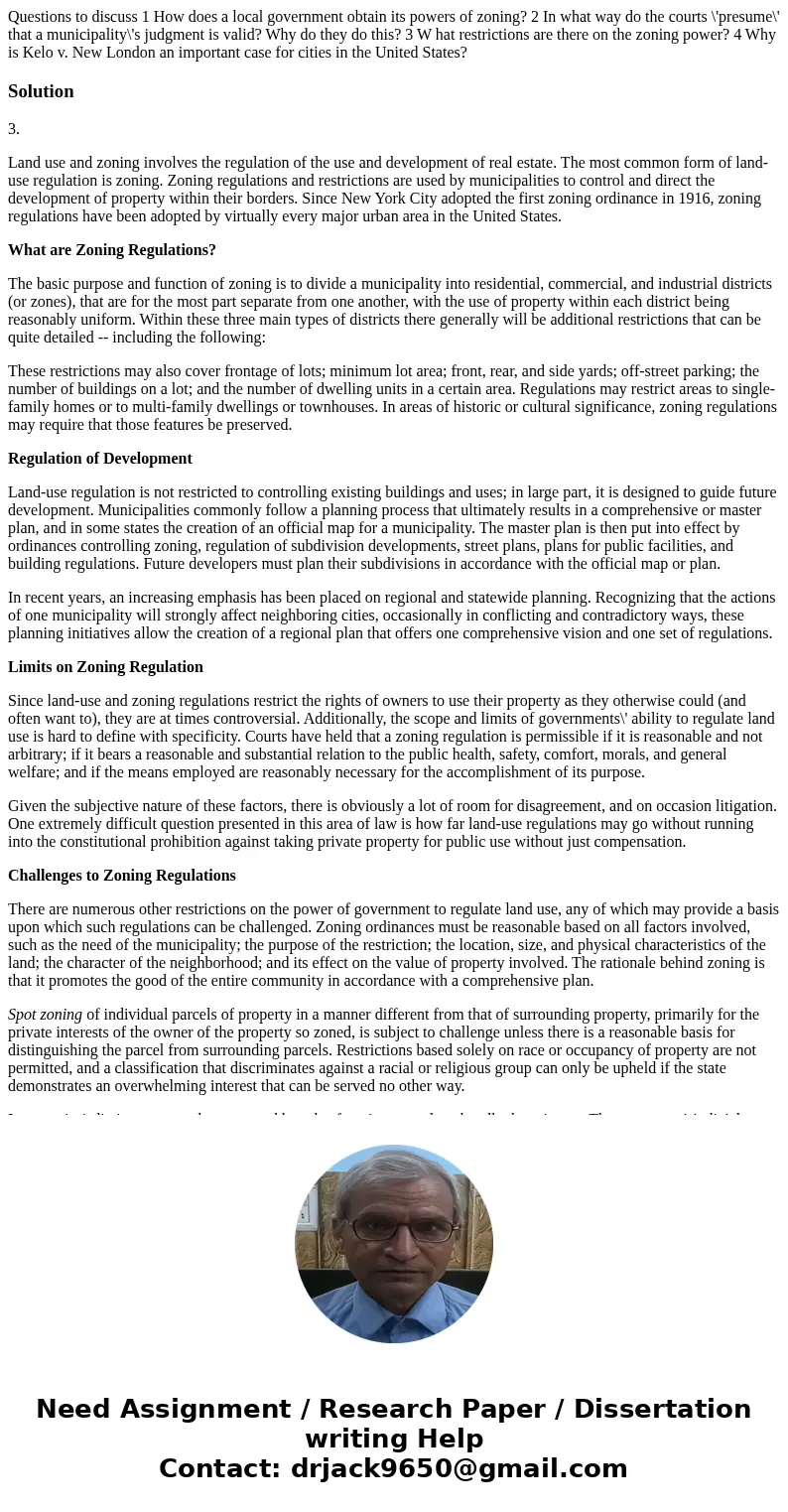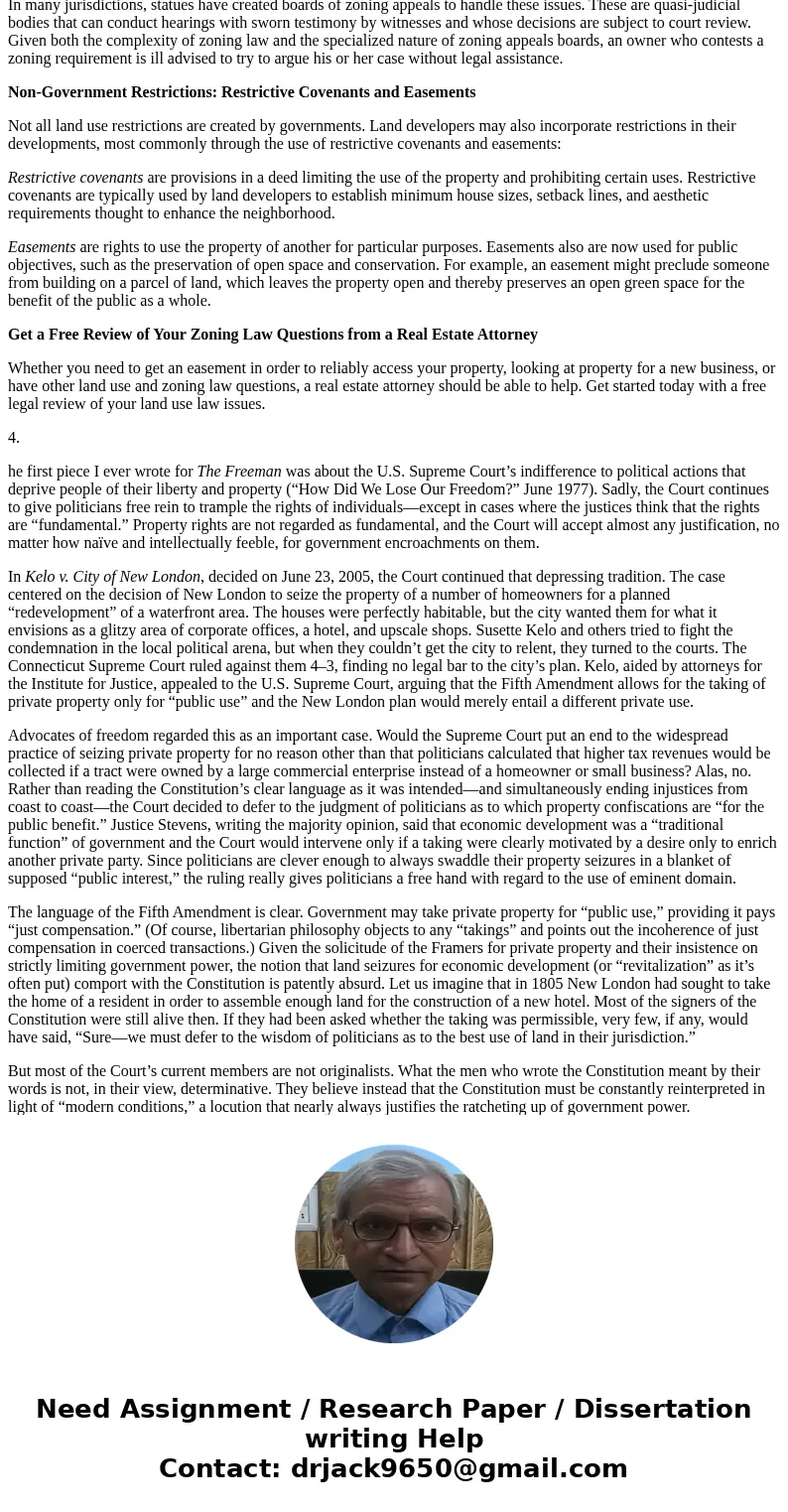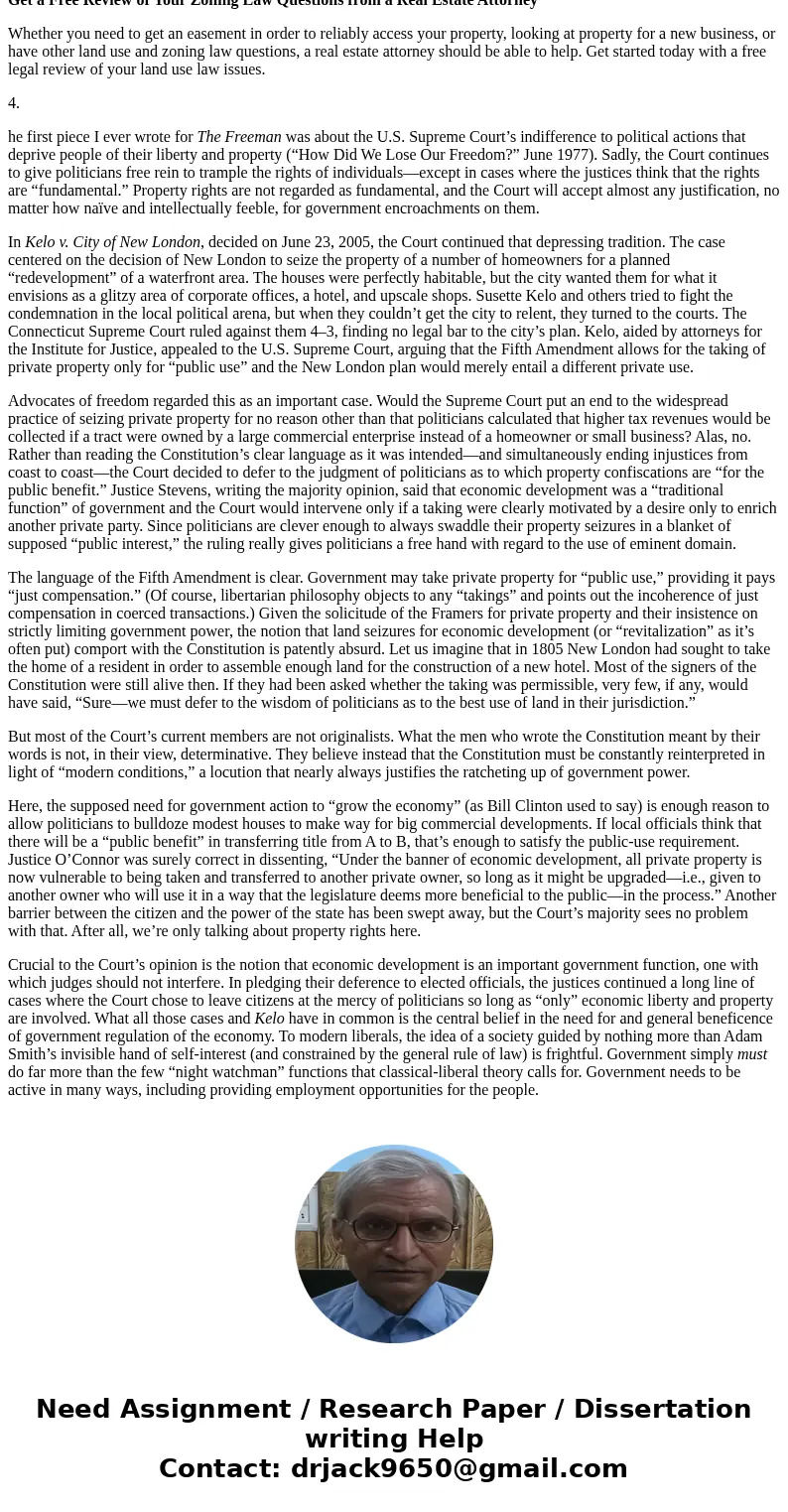Questions to discuss 1 How does a local government obtain it
Solution
3.
Land use and zoning involves the regulation of the use and development of real estate. The most common form of land-use regulation is zoning. Zoning regulations and restrictions are used by municipalities to control and direct the development of property within their borders. Since New York City adopted the first zoning ordinance in 1916, zoning regulations have been adopted by virtually every major urban area in the United States.
What are Zoning Regulations?
The basic purpose and function of zoning is to divide a municipality into residential, commercial, and industrial districts (or zones), that are for the most part separate from one another, with the use of property within each district being reasonably uniform. Within these three main types of districts there generally will be additional restrictions that can be quite detailed -- including the following:
These restrictions may also cover frontage of lots; minimum lot area; front, rear, and side yards; off-street parking; the number of buildings on a lot; and the number of dwelling units in a certain area. Regulations may restrict areas to single-family homes or to multi-family dwellings or townhouses. In areas of historic or cultural significance, zoning regulations may require that those features be preserved.
Regulation of Development
Land-use regulation is not restricted to controlling existing buildings and uses; in large part, it is designed to guide future development. Municipalities commonly follow a planning process that ultimately results in a comprehensive or master plan, and in some states the creation of an official map for a municipality. The master plan is then put into effect by ordinances controlling zoning, regulation of subdivision developments, street plans, plans for public facilities, and building regulations. Future developers must plan their subdivisions in accordance with the official map or plan.
In recent years, an increasing emphasis has been placed on regional and statewide planning. Recognizing that the actions of one municipality will strongly affect neighboring cities, occasionally in conflicting and contradictory ways, these planning initiatives allow the creation of a regional plan that offers one comprehensive vision and one set of regulations.
Limits on Zoning Regulation
Since land-use and zoning regulations restrict the rights of owners to use their property as they otherwise could (and often want to), they are at times controversial. Additionally, the scope and limits of governments\' ability to regulate land use is hard to define with specificity. Courts have held that a zoning regulation is permissible if it is reasonable and not arbitrary; if it bears a reasonable and substantial relation to the public health, safety, comfort, morals, and general welfare; and if the means employed are reasonably necessary for the accomplishment of its purpose.
Given the subjective nature of these factors, there is obviously a lot of room for disagreement, and on occasion litigation. One extremely difficult question presented in this area of law is how far land-use regulations may go without running into the constitutional prohibition against taking private property for public use without just compensation.
Challenges to Zoning Regulations
There are numerous other restrictions on the power of government to regulate land use, any of which may provide a basis upon which such regulations can be challenged. Zoning ordinances must be reasonable based on all factors involved, such as the need of the municipality; the purpose of the restriction; the location, size, and physical characteristics of the land; the character of the neighborhood; and its effect on the value of property involved. The rationale behind zoning is that it promotes the good of the entire community in accordance with a comprehensive plan.
Spot zoning of individual parcels of property in a manner different from that of surrounding property, primarily for the private interests of the owner of the property so zoned, is subject to challenge unless there is a reasonable basis for distinguishing the parcel from surrounding parcels. Restrictions based solely on race or occupancy of property are not permitted, and a classification that discriminates against a racial or religious group can only be upheld if the state demonstrates an overwhelming interest that can be served no other way.
In many jurisdictions, statues have created boards of zoning appeals to handle these issues. These are quasi-judicial bodies that can conduct hearings with sworn testimony by witnesses and whose decisions are subject to court review. Given both the complexity of zoning law and the specialized nature of zoning appeals boards, an owner who contests a zoning requirement is ill advised to try to argue his or her case without legal assistance.
Non-Government Restrictions: Restrictive Covenants and Easements
Not all land use restrictions are created by governments. Land developers may also incorporate restrictions in their developments, most commonly through the use of restrictive covenants and easements:
Restrictive covenants are provisions in a deed limiting the use of the property and prohibiting certain uses. Restrictive covenants are typically used by land developers to establish minimum house sizes, setback lines, and aesthetic requirements thought to enhance the neighborhood.
Easements are rights to use the property of another for particular purposes. Easements also are now used for public objectives, such as the preservation of open space and conservation. For example, an easement might preclude someone from building on a parcel of land, which leaves the property open and thereby preserves an open green space for the benefit of the public as a whole.
Get a Free Review of Your Zoning Law Questions from a Real Estate Attorney
Whether you need to get an easement in order to reliably access your property, looking at property for a new business, or have other land use and zoning law questions, a real estate attorney should be able to help. Get started today with a free legal review of your land use law issues.
4.
he first piece I ever wrote for The Freeman was about the U.S. Supreme Court’s indifference to political actions that deprive people of their liberty and property (“How Did We Lose Our Freedom?” June 1977). Sadly, the Court continues to give politicians free rein to trample the rights of individuals—except in cases where the justices think that the rights are “fundamental.” Property rights are not regarded as fundamental, and the Court will accept almost any justification, no matter how naïve and intellectually feeble, for government encroachments on them.
In Kelo v. City of New London, decided on June 23, 2005, the Court continued that depressing tradition. The case centered on the decision of New London to seize the property of a number of homeowners for a planned “redevelopment” of a waterfront area. The houses were perfectly habitable, but the city wanted them for what it envisions as a glitzy area of corporate offices, a hotel, and upscale shops. Susette Kelo and others tried to fight the condemnation in the local political arena, but when they couldn’t get the city to relent, they turned to the courts. The Connecticut Supreme Court ruled against them 4–3, finding no legal bar to the city’s plan. Kelo, aided by attorneys for the Institute for Justice, appealed to the U.S. Supreme Court, arguing that the Fifth Amendment allows for the taking of private property only for “public use” and the New London plan would merely entail a different private use.
Advocates of freedom regarded this as an important case. Would the Supreme Court put an end to the widespread practice of seizing private property for no reason other than that politicians calculated that higher tax revenues would be collected if a tract were owned by a large commercial enterprise instead of a homeowner or small business? Alas, no. Rather than reading the Constitution’s clear language as it was intended—and simultaneously ending injustices from coast to coast—the Court decided to defer to the judgment of politicians as to which property confiscations are “for the public benefit.” Justice Stevens, writing the majority opinion, said that economic development was a “traditional function” of government and the Court would intervene only if a taking were clearly motivated by a desire only to enrich another private party. Since politicians are clever enough to always swaddle their property seizures in a blanket of supposed “public interest,” the ruling really gives politicians a free hand with regard to the use of eminent domain.
The language of the Fifth Amendment is clear. Government may take private property for “public use,” providing it pays “just compensation.” (Of course, libertarian philosophy objects to any “takings” and points out the incoherence of just compensation in coerced transactions.) Given the solicitude of the Framers for private property and their insistence on strictly limiting government power, the notion that land seizures for economic development (or “revitalization” as it’s often put) comport with the Constitution is patently absurd. Let us imagine that in 1805 New London had sought to take the home of a resident in order to assemble enough land for the construction of a new hotel. Most of the signers of the Constitution were still alive then. If they had been asked whether the taking was permissible, very few, if any, would have said, “Sure—we must defer to the wisdom of politicians as to the best use of land in their jurisdiction.”
But most of the Court’s current members are not originalists. What the men who wrote the Constitution meant by their words is not, in their view, determinative. They believe instead that the Constitution must be constantly reinterpreted in light of “modern conditions,” a locution that nearly always justifies the ratcheting up of government power.
Here, the supposed need for government action to “grow the economy” (as Bill Clinton used to say) is enough reason to allow politicians to bulldoze modest houses to make way for big commercial developments. If local officials think that there will be a “public benefit” in transferring title from A to B, that’s enough to satisfy the public-use requirement. Justice O’Connor was surely correct in dissenting, “Under the banner of economic development, all private property is now vulnerable to being taken and transferred to another private owner, so long as it might be upgraded—i.e., given to another owner who will use it in a way that the legislature deems more beneficial to the public—in the process.” Another barrier between the citizen and the power of the state has been swept away, but the Court’s majority sees no problem with that. After all, we’re only talking about property rights here.
Crucial to the Court’s opinion is the notion that economic development is an important government function, one with which judges should not interfere. In pledging their deference to elected officials, the justices continued a long line of cases where the Court chose to leave citizens at the mercy of politicians so long as “only” economic liberty and property are involved. What all those cases and Kelo have in common is the central belief in the need for and general beneficence of government regulation of the economy. To modern liberals, the idea of a society guided by nothing more than Adam Smith’s invisible hand of self-interest (and constrained by the general rule of law) is frightful. Government simply must do far more than the few “night watchman” functions that classical-liberal theory calls for. Government needs to be active in many ways, including providing employment opportunities for the people.



 Homework Sourse
Homework Sourse